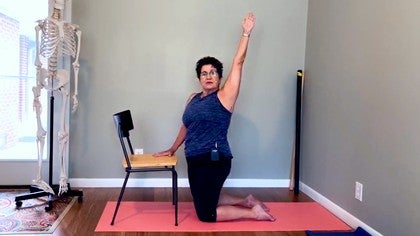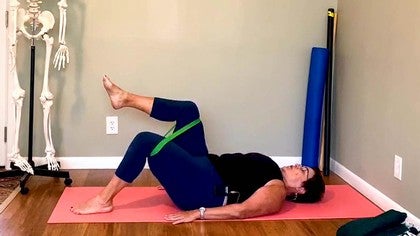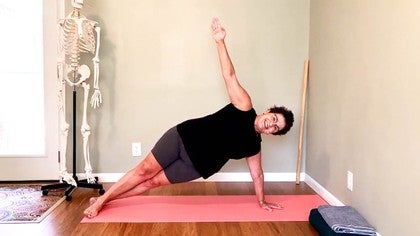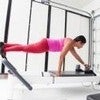Description
About This Video
Transcript
Read Full Transcript
Each moment is a choice. No matter how frustrating or boring or constraining or painful or oppressive or fabulous our experience, we can always choose how we respond. And then, finally, I begin to understand that I too have a choice daily. I'm glad you made this choice today. Keeping up with our power of props.
We're going to use a chair today to make several different key connections. And then after we make the connections, we'll tie them into some of the regular exercises. I call it the power of props because, to me, propping allows you to feel a connection for the exercise that you're about to do. Or propping allows you the opportunity to challenge a little something. Today we're using the chair.
You'll see that I have two chairs here. This chair with the handles or with the. This is my outside chair. And sometimes when I'm outside in the morning, I do things on this chair. There'll be a couple of things that I'll bring this chair back into the picture for, but it's kinda big.
So I'm just gonna move it out of the way for now. And then we'll take this chair. So this is more like a desk chair. And, again, you can use a stool. You can use chair.
We're just gonna stand here in front of the chair. Oh, about a hip distance apart. And then you're just gonna start by doing this. So it's one leg up and the other leg up. All's we're doing here is differentiating the hip from the pelvis.
I'm not bucking my body. I'm not extending my spine. I'm doing lumbopelvic stability. My core is gently engaged, not massively so. I'm gonna do five more.
And four and three and two and one and rest. Now I'm gonna take my left leg, put it up on the chair and I'm gonna start to make a right angle at this knee. And then I'm gonna lunge myself forward. My hands are on the back of the chair just touching. If your chair doesn't have this back, you just keep your hands here.
So now I'm lunging forward all the way through my back ankle hinge. And then I'm pushing up. Inhale, exhale. Breathe in and out. As we do these exercises, starting with the ankle, to the knee, to the hip, getting all warmed up in these large muscles.
Warmed up in our hip for hip mobility. Now I'm gonna come forward, stay forward. Arms raise up and down. So now I'm holding my hips constant. Gently attracting my belly backwards.
And I'll do two more. And then last one. And then I'll bring myself back. Switching legs. Opposite leg comes up, create this right angle first at the knee.
And then I just lunge forward and back. Both of my feet are pressing down into the ground, forward and back. Add the arms. Add the arms up. It's your choice here.
So we're just using the level change of the chair to create this awareness. Two more. And then last one and then come back. Sagittal plane movement, warming up the hips. Here's the next one.
Left leg returns back to the chair. My belly is drawn backwards. I'm vertical as I can be. Hands come behind the head. Transverse plane, trunk rotation.
Inhale, twist towards the bent knee. Exhale, center. Inhale, twist. Exhale, center. Anterior oblique sling, right to left.
Three more, two more, last one. Come back to center. Hold the trunk straight. Heel raise on the right leg. Up, down Up, down.
You wanna be really mindful when you go up and down that you don't just jut your bottom forward, that you use the power of your calf to the back of your hamstring. Like the exercise running or tendon stretch on the reformer. Let's get five more here. And four and three and two and one. Come down.
Switch legs. Right leg up. Going to our transverse plane, trunk rotation. First, stabilize left leg, left buttocks. Rotate trunk to the right.
Inhale. Fill up. Remember last week's class. We're not going to grip. We're gonna fill. Inhale, right.
Exhale, center. Inhale. Did you know that you can lengthen your rib cage without arching your back? So feel your front ribs and your back ribs get tall. Let's do two more.
And last one and pause. Left heel raise. Up, down. 10 times. Make sure your elbows are in your peripheral vision.
That is a very important so that you're not just arching your back if you open your elbows wide. The hands behind your head offer your rib the opportunity to pick up off of your pelvis. We got two more. And then last one. And then lower the leg down.
Two hands come down. Nod your head. Round your torso. Take your hands to the top of the chair. Press your hands down.
Straighten your elbows. Lift up your heels as if you're trying to smash the chair to the floor. Lower down, inhale. Exhale, head gently nod. Thighs turn on.
Look at your ankle creases. And then look at your knees. And then talk to your thighs and scoop that belly in anymore. And then release. One more time.
I just got a flexion cramp in the front of my ribs. Hold this up here. Now, hold this pike position. Bend knees, straighten knees. Bend knees, straighten knees.
Are you still pressing your arms? The blades are coming away from your spine in a protracted position. And we'll look at that again in a little bit. Let's do three more of these pikes. Two more and last one and lower down.
Let your hands go. Tighten up your tush. Bringing yourself all the way up. Next sequence is a lunge sequence. It looks like this.
Left leg up, left leg down, left leg back, stand up. Left leg up, left leg down, left leg back, stand back up. That's two. We're going to five. Here's three.
And down and back and up and four. Down, back, up. And five, down, back and up and rest. Switch legs. Right leg up and down and back and rest.
Up and down. Lunge back, stand up. Here's the third one. And down and back and up and four. And five.
Should have a little bit of breath going there. Next sequence is a lunge with trunk rotation. It looks like this. I'm gonna use the chair for like an elevated plank. I've moved myself to the lateral side of the chair.
It's my left side towards you. I'm gonna take my left leg forward and reach my back leg back. And I'm going to attempt to make roughly a right angle at this hip. My body is pitched forward. It's not up tall.
Belly is pulled in. Right arm pressing somewhere on the chair. Arm up, all around, and up and down. As I lift my arm, my rib cage lifts. My blade on my left side is helping me to turn my trunk up and around.
That's two. We'll get to five. Up you go, around. Up and forward. Minimize arcing your spine, but maximize the length of your ribs.
That makes a lot of room for the shoulders. And we'll call this the last one. And back and up and around. Step forward. We'll go to the other side.
Take the time here to deliberately let your right knee come forward. Your spine is pitched forward. It's relatively in neutral if I had a stick behind my sacral area. Right arm up. I open the chest.
I twist my trunk. I wish I had something really clever on my t-shirt to have a saying. And then up and down. Yes, your legs are loaded. Yes, your legs are loaded.
And yes, your back knee is straight. And yes, your front knee is bent. And come around. We got one more like this. Actually two more. And around.
Last one. Reach the arm. Now twist your thorax. Don't just throw the arm back. But twist your entire thorax.
That leaves the most room for your shoulder. Come on back. Step up. Rest right there. Take an inhale.
Nod your torso down. Hands on the bar. I mean on the chair or it'd be on the bar. Of course, if you were at the edge of the reformer. And lift up and down.
Use this as an opportunity, I am, to catch my breath. Getting information from my calves, all the way to the back of my thighs. Pulling the belly in, stay. Bend your knees to rolling like a ball shape. Bend, press.
(Karen sighing) Last one. Legs come down. Tighten up your bottom. Bring yourself all the way back up. Now we'll come to kneeling.
Kneeling in front of the chair. Taking a look now at what's gonna happen to the shoulder blades when they're all the way over your head. So take a moment here and just kind of reach your hands towards the front edge of the chair. Sit yourself back and just kind of monitor this position. You can watch me for a second.
We'll do this several times. So what I want you to feel here is that, as my arms go over my head, which is shoulder flexion, the upper part of my chest lengthens. When my arms are like this, if you were standing above me, I can actually pull my shoulder blades towards my spine. Especially the upper part of the blade. Because my full blade is an upward rotation.
And the bottom part of my blade is way out here to the side. So you're gonna hold this and then bring yourself up and down. So my forearms are on the edge of the chair. My elbows are straight. My elbow creases are facing each other.
And then bring yourself up. Now, moving yourself closer to the chair. This gets a little bit trickier. Elbows come on the chair like this. I start to lengthen my torso back.
If I choose, I can actually curl my lower belly a little bit. So I don't dump into extension of the spine in my low back because I want my upper spine to receive a little bit of moment of lengthening. Notice my palms are supinated. It means my palms are facing behind my back. My head is barely at the edge of the chair.
Inhale. As I exhale, my elbows will push this chair forward as my chest goes further back. And my head comes under the chair. Breathe three breaths. (Karen sighing) And then bring yourself back up.
That exercise is actually the start of a backbend because your arms go all the way back. Now, we're gonna continue on with the shoulders. You're gonna bring your body kinda to the front of the chair. One hand on the chair. I'm gonna take my right hand.
My left hand is gonna go in front and up. As I press down with my right hand on the chair I'm gonna start to turn my chest. As I turn my chest. It's my chest and my thorax. We'll address this in the last class again, about thoracic mobility.
And then I'm gonna turn this arm around or rotate this arm around and then come forward. My arm in front is pressing down to try to keep me as vertical as I can. As I open up the range of motion of my shoulder. One more time. Pressing your shins down.
As I rotate my trunk to the left, my right knee presses down, and I turn any bit more. Come around. Pressing your left arm down, the right arm raises up. I give a twist. I open the chest and come around.
Three times. Reach up. If there starts to be a stickiness in the shoulder, we really have to get the upper collarbone to raise up and back. The AC joint, so important. Acromioclavicular joint. Reaching up and back.
It's not your neck. It's up and back and let's do one more. Front belly stays back. Arm gently pressing down. Trying to keep your torso as vertical as you can as you rotate around the axis of your spine.
And then bring yourself all the way back. Two hands on the chair. Press the chair down. Curl the toes underneath you. You're coming to a plank.
Bring yourself into this plank position, lifting the heels and taking your shoulders over your wrists. In this position here, your shoulders are neither over rounded or overhanging, but they're active. Like I'm trying actually to pull this chair towards my thighs. Hold this for about 10 more seconds. And nine, eight, seven, six, five, four, three, two, one.
Step forward. Step forward. Tighten your bum. Stand up. That's one.
We'll do three. I won't know if you do it. If you need to take a break, that's certainly fine. And hands come down. One leg out to plank.
Other leg comes out. To tidy up myself, I press my arms. I take that chest that I created just a second ago on the chair and I pull it forward. I push my hands down. I pull the chair towards me.
Ten, nine, eight. Six, four, two, one. Step forward. Step forward. Come up.
Inhale. This is gonna be the last one. Notice if you're someone that wants to bend your elbows and make a special notice that when you bend your elbows a little bit, the weight might come to the outside of your fingers and you extend your neck. So we want the weight to go over the radius bone. Above the thumb, straight elbow.
10. Five. Last one. Bring yourself up. Take the arms up to the ceiling.
Pull your belly up and in. Reach your palms long. Take your arms out to the side. Pause right here. Spine twist to the left.
Both of your arms stay equidistant apart as you twist. Come back to center. Twist to the other side. So don't be overzealous with the arm. Be overzealous with the chest and the thorax rotating.
Come back to center, rest. To the plank position. And we're going to do a little mini burpee. Watch. Plank, plank.
In, in, jump. Plank, plank. In, in, jump. Plank, plank. In, in, jump.
Plank, plank. In, in, jump. Plank, plank. In, in, jump, With the hands now. Plank, plank.
In, in, whee! Plank, plank. In, in, arms. Reach, reach. In, in, arms. Reach, reach.
In, in, arms. Last one, last one. In, in, arms. Pause. Round the spine.
Take your hands to the chair, lift your heels up and down. Round your spine and round your spine and round your spine. And rest. Back down onto your knees. Take yourself all the way forward to your chair.
Open up your chest. Pull the chair almost in so that you kind of feel your buttocks. Watch, I'm gonna exaggerate. Push the chair over. I don't want you to do that.
But sometimes I do a class where I call take it to the wall. And I have you bring the front of your hip creases very close to the wall. Because now that we've opened the chest, breathed through the ribs. Now we're gonna do spinal extension. So come up.
Palms flat. Push the ceiling. Do not take your belly, your lowest belly, away from the chair, but squeeze your upper shoulder blades back and lift your chest up and coil over the back of your chest. And then come up. Five times.
Lengthen the ribs first. That's the whole package of your ribs lifting up. Exhale, pause, stay lifted. Now inhale into your back. Then push the palms of the hand.
Squeeze your upper shoulder blades together. The acromioclavicular joint is elevated and then come back. Whew. That's just two. Here we go again. Arms up, lengthen, extension through the thorax.
Push your palms up. Reach up. If you find yourself wanting to throw your head back then just look forward for a second and keep lifting the chest. Keep lifting the chest until you can arc your heart and then come forward. Rest.
Was that three or four? I can't remember. Okay. I think we've got one more. Here we go. Arms up, shins down, right.
Shins down to get the back of the thighs all tidied up. Reach up with the belly and the ribs, palms reaching. Arc the chest. Take yourself up. Don't lose your low belly on the chair.
Don't lose it. Go back as far as you can. Hold and then lead with the chest to come back up. Hands come down on the chair. Sit yourself back.
Pause. We'll revisit that in a little while when we change chairs. Now we lie on the back. You're gonna lower your trunk down. Bend both your knees.
Your feet will come on top of the chair. If the chair. Actually I have this mat here, because if the chair is kinda hard, sometimes I put an extra mat on it or a blanket or something here. Okay. So when this position here, don't be so tight in 90 90 'cause you wanna leave room for your pelvis.
But the first exercise here is actually an interesting one. The, the long leg is gonna go down on the floor. Tidy up those shoulder blades in the back. As you draw your belly up, try not to pull it so hard that you tense in your chest like this, okay? So just draw your belly in.
You may need something under your head if you're somebody whose chin lifts up. All right. So with your right leg pressing down on the chair. This exercise mimics the exercise called parakeet or push through with the feet. So my bottom leg, the left one in this case, is gonna come out from under the chair and go up.
Bend and down. So I don't wanna move all the way back to make it really easy, but I wanna pull this thigh in without shortening the front of my body. So this is like single-leg stretch, pulling that thigh in and then it goes up. And then I pull the thigh into my belly and reach it down. I think you get the gist.
Here we go. In, up. In and down. In, and my right leg, incidentally, is pressing down. Yeah. It helps me with where those butt bones need to be.
Got tight hamstrings? It just looks like this. Two more. And then last one Reach long and then switch. Put that left leg on top.
Take your right leg down and long. Stretch it out. Close any daylight underneath that right thigh. Draw your abdominals in. And then right knee in, up, in and reach.
Try not to tilt your pelvis to move the thigh. That would become a tilt. And we'll do that exercise after. But what we're looking for here is really a heaviness of the bottom. A stabilization in the trunk.
And then, of course, challenging it with one leg. Come in. Two legs on the chair. Rest. Now, move your bottom a little bit closer to your chair and see if you can indeed rest your legs on the chair.
It might be imperfect. Your chair might be shorter or taller, but just the bottom line here is that no legs right now. We did this last week in the little ball class. So I don't want you to squeeze your butt like this. I want you to deepen the belly and roll your pelvis up.
Shortening the front. I'll put my hands on my pubic bone and then unroll it Breath in. Breath out. Scoop and curl. Hold.
When you let go, don't just stop the exercise. But unroll it. Spinal mobility at the bottom. I'm not using my butt at all. It's all jiggly.
It's just melted like butter. Makes me think of pancakes. And then release one more time. Tip and curl the pelvis. Now, in this position, feel the pelvis tilted.
Feel the pelvis tilted. Feel your belly active. Feel your butt not doing much. And then release. Now, move yourself a little further back.
Take your feet on top of the chair. Initiate the pelvic curl with your belly. And then as you start to lift up, you'll feel when your butt and your thighs have to work. We're gonna be here for several repetitions. The goal here is to build this bridge.
So you're not going to come up as high as you can initially. You're gonna come up almost like a bottom lift and then drip your ribs down. As a matter of fact, we're not really lifting past the ribs at all. (Karen sighs) We're getting the initiation from the back of the thighs, the higher part of the hamstring, and the lower part of the glute. And we'll do two more.
What are the blades doing incidentally here? They're actually should be pulling towards each other almost as they keep that chest in its presentation mode. And then release yourself all the way down. Little hamstring dynamic stretch afterwards. Try to keep your bottom heavy.
Just lift your leg up and down a couple of times. Switch it with the other one. Hamstrings were just working. Now what we have to do now is we're going to go back to the bridge position. We're gonna fold the left knee into the chest so that it kind of creates spinal flexion of the bottom.
A combination of the tip and curl and the leg being held in. That way, when I initiate my bridge with my opposite leg, my arms aren't down on the ground helping me. But I'm just getting that initiation away from the bottom of the right butt. And because my opposite knee is into my chest, I'm not rushing into my spinal extensors. That will come, but first we're building.
Let's get three more, two more. And then the last one and rest. Bringing my right knee into my chest. Pressing my left foot down. I tip and curl my pelvis and I initiate.
I initiate from my bottom and I don't care how high I'm lifting. Three more. Initiate. Two more. And then last one.
And then rest. Now put your feet on the floor. Notice how my knees are kind of close to that chair now. So I can imagine that when I lift up into a fuller bridge, I'm gonna actually tell myself, wow, I wonder if I can just push my knees into that chair a little bit. Not to push it over, but just so that I can keep that lengthening away.
So now in this bridge, my pubic bone, my pelvis are level. My bottom is fully engaged to use my hip extensors to lift up. My quadriceps are even engaged. Now I'm gonna take this extension through my chest. So watch my shoulder blades squeeze into each other.
And then I'm gonna take my sternum to my chin. Not my chin to my sternum, okay? Sternum to chin. And then lower down. This exercise will become leg pull, face up.
But we have to build the bridge here to level. Then, as we journey up the spine, we lift the chest. I reach my arms very long. I hold and then I lower down. We'll do this one more time.
Lift up, hold up. Count to five. Neck is soft. Eye sockets pulled back. Three, reach the knees to the chair.
Two, and one. And lie myself all the way down. That's our bridging sequence. Bring yourself up to sitting. Separate your legs.
Fix your shirt. Fix your shirt. Reach your arms out long on the chair. Now you have to make a notice here. I can't really see myself.
So I'm feeling that I'm relatively vertical in my spine. If I were to be sitting like this, I may need to put a little something under my butt. But sometimes, really, seriously in spine stretch what happens is we're so worried about not rounding that we actually create this. We certainly don't want that. So having your hands be on the chair And gently pressing the chair down allows me to feel the lift of the belly up.
I hope you can see that. Take an inhale here. As I exhale, chin nods. The arms slide forward and I'm rounding over my pelvis without leaning my pelvis forward into a hip hinge. Look at my legs.
I can contract my legs, stabilize my legs. Rounding the trunk, take an inhale while you're down here. Filling the back lungs. Exhale belly back. Trunk curls.
Bring yourself back up. Inhale again. Exhale. The nodding of the head. The reaching forward of the arms in the blades. The scooping in of the belly.
Flexion connection in the front body. Pause. Inhale here. Exhale. Bring yourself all the way back up.
Now, take your bottom back. Hip hinge. In a hip hinge, your pelvis is level my spine. Excuse me. My sacrum is vertical.
My spine is coming directly vertical. As I hip hinge forward, I bow forward. I keep all my packaging in check. And then I sit back up. I'm just leaving my arms here because I don't want that to get in the way of what you might see.
So as I hip hinge forward, I'm really not changing anything between my pubic bone, my sternum, excuse me. My xiphoid process. My sternum, the crown of my head. Then I come up. Now I can take my arms here.
Hip hinge but be careful because we don't want the hip hinge to turn into a collapsion, okay? So hip hinge. Return. What's the hip hinge backwards? Neck pull, right? Hip hinge forward and back.
Now let's take the hands behind our head. Let's hip hinge back. Whoa. And then forward. You will feel your hips.
They have to hold you while you maintain your front line with integrity. Can you hip hinge forward? Center. Can you hip hinge back? Center.
Can you twist and hip hinge? And hip hinge, right? So we can do all these different activities with a hip hinge. Very good. Bring your arms down.
Now the legs come to cross in the front. With the legs crossing in the front. I like to cross at the shins. Okay, so that my legs. So that my knees are kind of, maybe not all the way in front of my hips, but they're certainly not butterflied out.
In this position here, I'm gonna actually pull my chair in so that I can reach the back of my chair. And right now, you know what? I'm not gonna worry about my hip hinge or around. I'm gonna mobilize my hips. So with my shins crossed and my body going forward and back.
You could do this with the magic circle, I guess, in front of you or the squishy ball or maybe one of those dynamic therapeutic balls. But I'm just able to use the chair here. This would be like a seated figure-four stretch if you'd like. But we already know those on the chair. We'll do those in a second.
And now switch which leg you had crossed in front. And then that would be the mat exercise crab, right? We'll do that in one of our sessions of me and my mat. We'll do the crab. Maybe we'll pull off a headstand.
Who knows? Okay. Hip hinge forward. Now I say hip hinge, because that is typically how this exercise is done, but I don't want you to get all carried away with that. I just want you to feel sensation in the back of the opening hips. Especially after we did all those lunges forward and back.
Maybe three more. And two more. And then last one. Good. So we've opened the arms. We've opened the hips.
We've worked the spine. Now we're gonna bring yourself up to the chair. I'm gonna move this chair outta the way now. And I'm gonna bring in this other chair. Because this chair, now.
This is my outside chair. And what this chair is going to allow us to do is fully express, for me, the leg pull face up. So we're gonna educate the blades here. If you don't have a chair with handles, you could certainly do it on the other chair or the edge of a bench or the edge of the short box or the edge of the reformer. It looks like this.
I'm sitting down in my chair. My hands are roughly on the side of the handles. I'm gonna take my upper AC joint, right? That angle actually goes upward and back. And since, right now, my blades are not, my arms are not coming out to the side or over my head.
They're gonna be in this back face. So the first part of this exercise is simply depressing my arms, watch, down. And that's actually my arms and my blades down. So here's shoulder elevation. Shoulder blade depression.
Elevation. Elbows straight. Press. One more time. Elevate the blades. One more time, depress the blades and hold the blades right here.
For five, for four, for three, and two and one. And rest. So we're differentiating their blade action, right? So that's long back stretch on the reformer. If you've never done that exercise, it's fine.
This just becomes a reverse plank in the mat. So now as I start to straighten out my legs, I need my entire back body to lift up. Just like in the front plank, we need the front body to lift up. It looks like this. I press my arms down.
As my upper collarbones get broad. I'm not rushing into lumbar spine extension. I'm gonna lift up, step forward one leg, step forward the other leg. And now as I lift my butt higher, guess what has to happen to my chest? The chest has to be presented from my blades squeezing together and my upper chest doing extension like we just did on our knees.
And then we come back and bring it down. That's one. Let's get three. So you play with it. I'll talk you through it if you're with me.
Otherwise you can do a couple on your own. So I like to get a little information and ask myself, can my blades indeed pull back without me dumping forward in my lumbar? My core protects my lumbar. My deep belly, my pelvic floor. The little tiny multifidi holding that spine.
And I'm gonna press up, reach out, push down. This is fine here. This is a nice back plank. But as I get myself into the chest lift, maybe I lift one leg and down. Maybe I lift another leg and down.
And then I resqueeze the blades, present my chest up, and then bring myself down. It wouldn't surprise me if you had a stretch almost through your bicep muscle because we tend to be kind of flexed forward, right? So this is a nice way to open up the front of the chest, front of the arm. Last one, best one. Here come my blades.
Here come my legs and my arms. I crawl out and we're gonna hold with the blades pulling in and the chest lifting up and the head starting to reach back. Only because the chest is lifting. For ten, nine, eight, seven, six, five, four, three, two, and one. And rest. Lower down.
That's what I love to use this outside chair for. I'm gonna take this away. Bring the other chair back. So we've done front plank. We've done back planks.
So we have a side plank. My goodness. So the planks are good. I have another class called all the planking and we'll do it in even different sequences. Okay.
So plank is about integration. Front body to arms and legs. Back body to arms and legs. And what else? Side body.
So just a quick trip around the spine here with this plank, and then we'll finish ourselves up here. So in this front plank, which we've already done. Heels lifted chest, over arms. Relatively in this nice straight position. I take my right arm.
I move it to the middle of the chair. I just turn my feet so one is in front of the other and I hold this plank position right here. Nothing fancy. I'm nice in line with my spine. Not dumping one way or another.
Feeling information under the right side. And then I come back to center and I come forward to plank. I move my left arm to the middle of the chair. My hand's getting a little sweaty here. I take my other arm up and I roughly squeeze my inner thighs at the top of my groins.
I hold for five more and four and three and two and one. Come back to center. Bring myself down. Crawl myself in. I'm gonna move the chair a little bit forward.
Be sure it stays in the frame. I'm gonna now come stand behind the chair. Standing behind the chair. Separate my legs. Actually I need to move this just a little bit more forward here.
So now. Standing exercises. Understanding what we have to do to get a squat. Now we're heading the end of our series here. So I'm not gonna pull out like a million squats but I do wanna work my way back to sitting in the chair.
So typically when people do a squat, they tend to do something like this. Which would be more of a hip hinge, right? So when you do a squat, the knees bend just a nanosecond before your hips go back. So the knees bend to load the quads. I'm gonna use the chair here in case I need the balance.
My shoulders are over my knees over my toes. Then I stand up. So you can see that if you do this, my shoulders are way over there. They're not over my knees, over my toes. So here we do five in a row.
Inhale. Exhale. (sighs) If you don't need the chair, you don't need the chair. If you need the chair and you go a little bit, I'm happy for you to do that. I'm pretty much happy. Most of the time.
Oh, we'll just do a couple extras. Shoulders over knees over toes. How 'bout two more? And then last one. This is what front frog kind of is, right?
When you're hovering down and then you push that pedal. All right. So now standing straight up here, turn to the sideways. Okay. So we're gonna open the chest. Hand is just on the chair for a little bit of balance.
Our sidekicks series a little bit in standing. This is about the extent of my dancing, right? Whoa. Legs balance. So let's lift the straight leg up, down, out, down, back, down.
Front, side, back, front. I'm doing a hip hinge because if I don't do a hip hinge, I'll get too backy. You know, I'll get too extendy. That's important if you're a big dancer to tie those together. But what I wanna do is work on the stability in one leg, mobility and the other.
One more time on this side. Front, side, back. Switch sides. Now be sure. Now you can see in the back. That we're not just resting into that hip, right?
So we have to kind of pull that hip in and keep that foot underneath the hip. Up, side, back. Up, side, back. Forward, side, back. Two more.
Forward, side, back. Last one. Forward, side, back, center. Turn and face the chair. Believe it or not, your squat will be a little bit better.
Five times. Knees bend just a little second before. And then stand up. The belly comes in as the arms lift up. Can your arms go all the way up and you be okay with your body pitching forward?
Because a squat is shoulders over knees over toes. One more. Very good. Come to sit on the front of your chair. Look at me.
I'm just doing "Ring around the Rosie" with the chair. But for some reason, I like to face away from the wall. It makes me feel like I have more space. So in this position here, you're relatively vertical. We're gonna close down by doing our spine stretch here without our legs.
So we're gonna pull the tummy in. Spine stretch forward, right? Like we're making this very big flexion connection in the front of the body. And then I'm gonna stack up and then lift up. Three of these.
Inhaling, grow. Exhale, flex. (Karen sighing) Inhale, grow. Exhale, flex. Bend the knees.
Move your bottom back in the chair a little bit. Now you're gonna be at deeper flexion. So I'm gonna pull my tummy in. I'm gonna go all the way down. So now I'm flexing at my hip and flexing at my spine.
So my hands are pushing down. My feet are pushing down and my belly is pulling in. There's really not a lot to see here but I need you to feel. Two hands, two feet pressing down. One belly pulling up.
And then can you take your hands back behind your heels. Maybe to the chair legs or maybe behind your heels, which will become seal, right? And when we do that in our mat class. So how tight can we get this flexion? And then bring yourself up.
And that will become also stomach massage on the reformer, right? But then the legs are this way. Oh, that woulda been a good exercise but we're winding down now. We don't need to build the massage. We'll save that for another day.
Rounding down. Scooping the belly. Bringing yourself all the way up. Stand up, turn around, straddle your chair. In this position here, be mindful.
Now my chair seems to have a little bend in it so it might push me to fall forward on my perineum. But what I wanna do is pull my belly up to try to keep my spine vertical. And then I'm gonna use the chair to untwist. I mean, to twist my spine. Taking my right shoulder blade towards my spine.
And my blade is helping me pull back as I twist. Pulling the belly in and up and twisting and coming back. Other side Left shoulder blade pulls back. Two feet press down. Get a twist.
Fill your breath up in the twist. Remember we started in standing with the twist, with our transverse plane. And then we take the hands in front. We stretch the legs out, almost kinda sorta like horseback. I push my chair back back.
I round forward. I point my toes. Flex my feet, bend my knees. Come up from flexion. Press down into my arms like down stretch on the reformer to lift my chest into extension.
Could also be seen kinda sorta like spread eagle right? nod the head. Flexion connection, front body. Horseback, lower body but without the inner thigh so much. I understand that.
Just creating a shape. And then flex the heels. Come back. Lift yourself up. Very good.
All right. I'm glad you made this choice today. Have a great week.
Key Connections: The Power of Props
Comments
You need to be a subscriber to post a comment.
Please Log In or Create an Account to start your free trial.




















